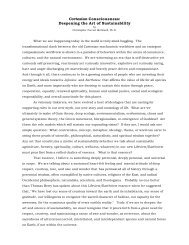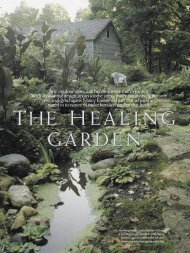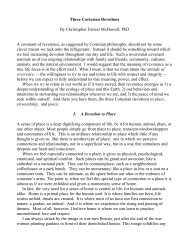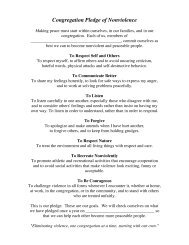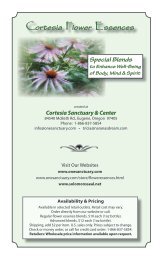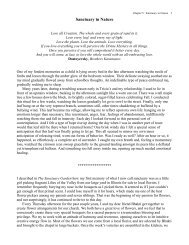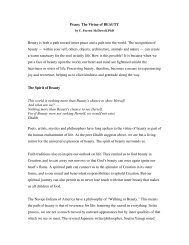Wellness: A New Map of Service
Wellness: A New Map of Service
Wellness: A New Map of Service
- No tags were found...
You also want an ePaper? Increase the reach of your titles
YUMPU automatically turns print PDFs into web optimized ePapers that Google loves.
Awareness (Step 1)Before we can expect to initiate a care process, we must be conscious <strong>of</strong> something going on (orwrong) inside our bodymindspirit system. Often we get the hit that something just doesn't "feel right."It's as if our system is knocked out <strong>of</strong> its state <strong>of</strong> dynamic equilibrium and is responding to the call <strong>of</strong>awareness: "What's happening?!"A wellness principle states that disease/illness, or dis-ease/discomfort are messages from within.That is, they always have meaning first in terms <strong>of</strong> our inner "feeling" state, and then are likely to findexpression in overt behaviors or conditions. In this sense, illness and discomfort are not necessarily bad;they merely are important psychosomatic messages to gain information from and to use for creativegrowth.It is absolutely critical, therefore, not to exclusively delimit the "feeling bad" state to only itsovert symptoms. This perhaps is one <strong>of</strong> the greatest flaws <strong>of</strong> the traditional medical model with itsextensive attention on treating symptoms instead <strong>of</strong> primary causes. <strong>Wellness</strong> practitioners, on the otherhand, have a respectful interest in the entire person --- their frame <strong>of</strong> mind and emotions, familial, social,and work structures which may cause stress or support, overall health/history, and so on.Awareness <strong>of</strong> imbalance within our whole system is really the true sign that we are not a closedsystem. In most cases, when we hurt in some way we have a very good idea as to its primary source,either external or internal to ourselves. Whether we can admit this to ourselves, or to another, is <strong>of</strong>ten atest <strong>of</strong> our receptivity to take responsibility for our healing. If we desire to continue toward self-care(healing), we must therefore integrate the next three steps into the regenerative process.Knowledge, Skills, & Resourcefulness (Steps 2, 3, & 4)Having first become aware <strong>of</strong> illness/dis-ease, we quickly move to a question <strong>of</strong> "What are myneeds to resolve this particular bodymindspirit state?" Very <strong>of</strong>ten, success <strong>of</strong> self-care is based upon apool <strong>of</strong> personal knowledge and skills in which to enact that knowledge. Deeper still is the ability to tapinto the well <strong>of</strong> resourcefulness within ourselves (<strong>of</strong>ten described as intuition, courage, inner strength,spirit, God-energy, and the like), and/or others. The fact is, effective wellness care is an important blend<strong>of</strong> knowledge and skills gained from others as well as from one's own reasoning and intuitive abilities.Another critical wellness principle states that any practitioner should be a facilitator whoprovides information, guidance, and resources for people to take care <strong>of</strong> themselves. They should alsobe prepared to help people develop self-maintenance skills. In this sense, the client's role is one <strong>of</strong>participator in their own healing and chooser in an egalitarian relationship committed to exploring andsupporting optimal wellness strategies. The result is expected to be an empowered individual who is



